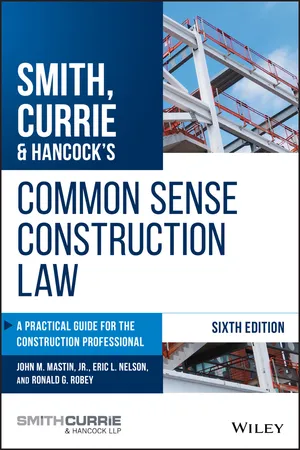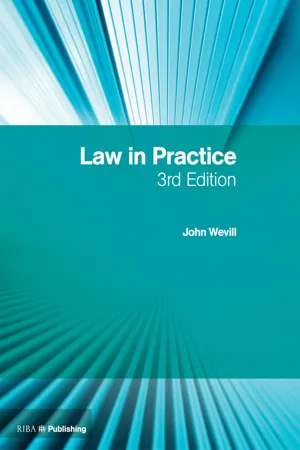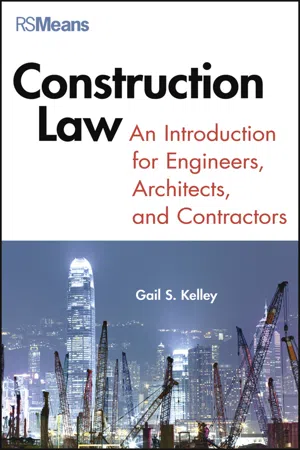Law
Construction Law
Construction law encompasses the legal regulations and principles that govern the construction industry. It covers a wide range of issues such as contracts, disputes, safety regulations, and environmental concerns related to construction projects. This area of law is crucial for ensuring compliance with building codes, protecting the rights of parties involved in construction projects, and resolving disputes that may arise during the construction process.
Written by Perlego with AI-assistance
Related key terms
1 of 5
4 Key excerpts on "Construction Law"
- eBook - ePub
Smith, Currie & Hancock's Common Sense Construction Law
A Practical Guide for the Construction Professional
- John M. Mastin, Eric L. Nelson, Ronald G. Robey, John M. Mastin, Jr., Eric L. Nelson, Ronald G. Robey(Authors)
- 2019(Publication Date)
- Wiley(Publisher)
1 THE LEGAL CONTEXT OF CONSTRUCTIONI. INTRODUCTION
Construction projects are complex and multifaceted. Likewise, the law governing construction is complex and multifaceted. Aside from questions of what one can do in construction, there looms also the issue of what one may do—that is to say, what the law of construction allows. So what is the law of construction? What factors influence the evolution of Construction Law?For practical purposes, the law applicable to construction projects falls into three major categories: contract, tort, and statutory/regulatory. Contract law may seem intuitively logical, at least on the surface. Tort law may not seem logical in application, but it is an omnipresent influence on any construction project. Statutory or regulatory law generally applies to construction simply because some governing body has said it should, whether or not the application is logical. This book discusses in detail these legal bases of Construction Law. In this first chapter, each theory is introduced in concept.II. CONTRACT LAW
A. What Is a Contract?
Contracts are the threads from which the fabric of commerce is woven. A contract may be as simple as an agreement to pay for food ordered in a restaurant, so complicated that no legion of lawyers could hope to decipher the real intent, or somewhere in between. Whatever their character, contracts govern the transactions that permeate our existence.Contracts and contract law1 dominate construction. What is a contract and what is contract law? A contract has traditionally been defined as “a promise or set of promises, for the breach of which the law gives a remedy, or the performance of which the law in some way recognizes as a duty.”2 Thus, a contract is basically a set of promises made by one party to another party and vice versa. Consequently, the heart of a contract is found in both its promissory nature and its enforceability.3 - eBook - ePub
Construction Law
An Introduction for Engineers, Architects, and Contractors
- Gail Kelley(Author)
- 2012(Publication Date)
- RSMeans(Publisher)
CHAPTER 2
BASIC LEGAL PRINCIPLES
2.1 LEGAL ISSUES IN CONSTRUCTION
Although construction is not as regulated as many other industries, law is still an integral part of the construction process. Most of the legal issues that arise in the construction industry involve contract law. Contract law governs the enforcement of voluntary agreements between parties and the resolution of disputes that arise under such agreements. Contract disputes on construction projects may also include issues related to agency law, as the owner is often represented by an agent such as an architect or engineer (A/E). Likewise, the contractor’s project superintendent is an agent for the contractor. Often the issue that arises is whether the agent had authority for its actions. Contract disputes may also include issues related to insurance law, such as whether a specific loss is covered under the terms of an insurance policy.Tort claims are not as common as contract claims but may arise between parties that do not have a contract. For example, the contractor may want to bring a negligence claim against the A/E because the A/E improperly rejected work. Tort claims may also be brought by third parties that are not involved in the construction project, such as adjacent landowners that have suffered property damage.Certain aspects of property law, such as easements and zoning regulations, can have a significant impact on a construction project. Such issues are typically governed by city or county ordinances. Property law also encompasses issues related to the transfer of title to land and buildings. When a project runs into financial problems, the relative priority of those who have claims on the title to the property may determine who gets paid.2.2 PRINCIPLES OF CONTRACT LAW
In legal terms, a contract is a promise that the law will enforce. The primary purpose of a contract is to state each party’s obligations and inform each party of its rights if the other party does not perform its obligations in accordance with the contract. An executed contract is one that has been signed by the parties; the parties that have signed the contract are said to be in privity of contract - eBook - ePub
Law in Practice
The RIBA Legal Handbook
- John Wevill(Author)
- 2019(Publication Date)
- RIBA Publishing(Publisher)
In a sophisticated, developed society, laws will develop or be created to govern all aspects of human behaviour and interaction, ranging from basic norms of personal behaviour to the rules which govern complex commercial transactions. The law of England and Wales, with which this book is concerned, is a highly developed, multifaceted system Construction Law is one aspect of this larger system.The idea of Construction Law as a distinct topic, worthy of study in its own right, is a relatively recent one.- The Building Law Reports, widely recognised as the leading authoritative law reports for construction-related disputes, first appeared in 1976 (the word ‘Building’ on the reports’ title page was originally represented in a variation of the Moore ‘Computer’ font, clearly marking them as a product of the late 1970s).
- The Society of Construction Law was founded in the UK in 1983.
- The Construction Law Journal was first published in 1990.
- The Technology and Construction Court acquired its current name on 9 October 1998, as a rebranding of the Official Referees’ Court.
The term ‘Construction Law’ is most helpfully understood as referring not to a separate entity, but rather to a broad range of general legal topics (such as contract law, tort and the supply of goods and services) specifically applied to the vast range of activities undertaken by the construction industry.The place of Construction Law in the construction industry is emphasised by the way in which the development, and promotion of the understanding of, Construction Law has been a collaborative process, involving the interaction of construction professionals as well as lawyers. This continued interaction is vital; without the input of construction professionals through bodies such as the Society of Construction Law, Construction Law would be less responsive, less relevant. Construction Law both governs and serves the industry.1.2 Why legal knowledge is valuable to architectsFor the architect, Construction Law sets the framework within which the practice of their core skills is to be carried out. Whether developing the design, securing consents and approvals, or managing the construction phase, all aspects of the architect’s work require a degree of knowledge of the legal context, beginning with the decision about whether or not to tender for a project, all the way through to RIBA Stage 7, post-practical completion, and managing the risk of ongoing liability in the years after the project has finished. - eBook - PDF
Construction Law
An Introduction for Engineers, Architects, and Contractors
- Gail Kelley(Author)
- 2012(Publication Date)
- RSMeans(Publisher)
15 BASIC LEGAL PRINCIPLES 2.1 LEGAL ISSUES IN CONSTRUCTION Although construction is not as regulated as many other industries, law is still an integral part of the construction process. Most of the legal issues that arise in the construction industry involve contract law. Contract law governs the enforce- ment of voluntary agreements between parties and the resolution of disputes that arise under such agreements. Contract disputes on construction projects may also include issues related to agency law, as the owner is often represented by an agent such as an architect or engineer (A/E). Likewise, the contractor’s project superintendent is an agent for the contractor. Often the issue that arises is whether the agent had authority for its actions. Contract disputes may also include issues related to insurance law, such as whether a specific loss is covered under the terms of an insurance policy. Tort claims are not as common as contract claims but may arise between par- ties that do not have a contract. For example, the contractor may want to bring a negligence claim against the A/E because the A/E improperly rejected work. Tort claims may also be brought by third parties that are not involved in the construction project, such as adjacent landowners that have suffered property damage. Certain aspects of property law, such as easements and zoning regulations, can have a significant impact on a construction project. Such issues are typically governed by city or county ordinances. Property law also encompasses issues related to the transfer of title to land and buildings. When a project runs into financial problems, the relative priority of those who have claims on the title to the property may determine who gets paid. 2.2 PRINCIPLES OF CONTRACT LAW In legal terms, a contract is a promise that the law will enforce. The primary pur- pose of a contract is to state each party’s obligations and inform each party of 2
Index pages curate the most relevant extracts from our library of academic textbooks. They’ve been created using an in-house natural language model (NLM), each adding context and meaning to key research topics.



